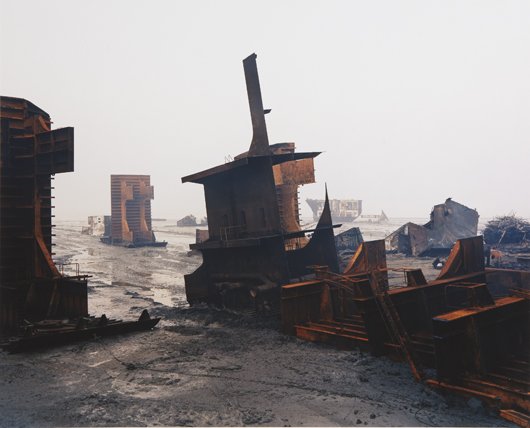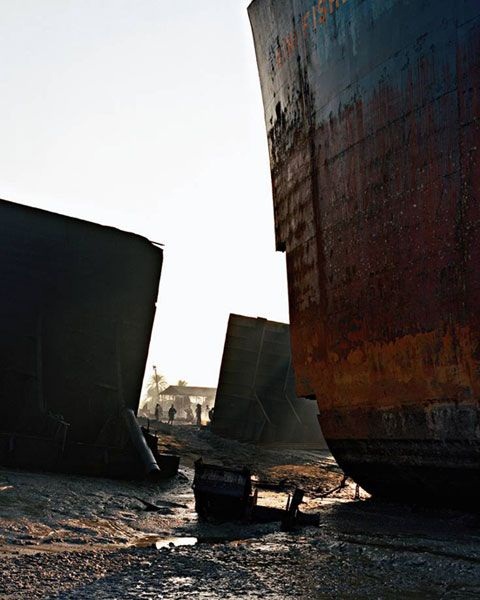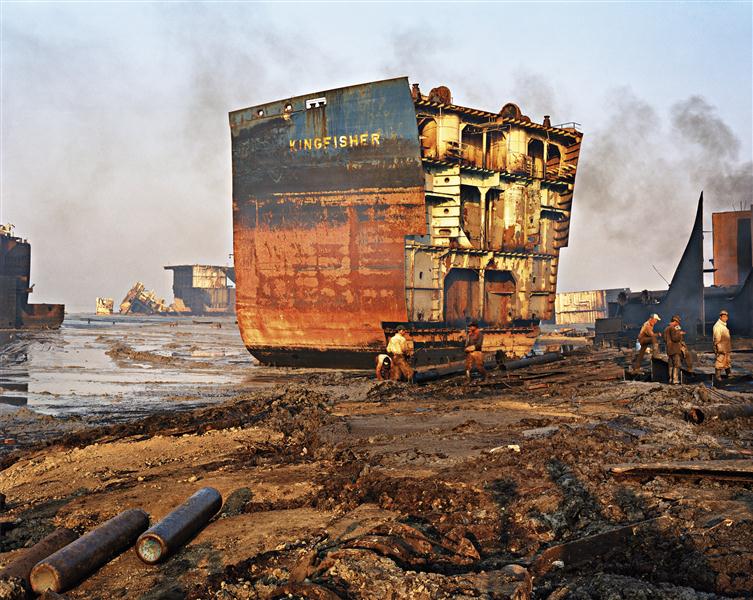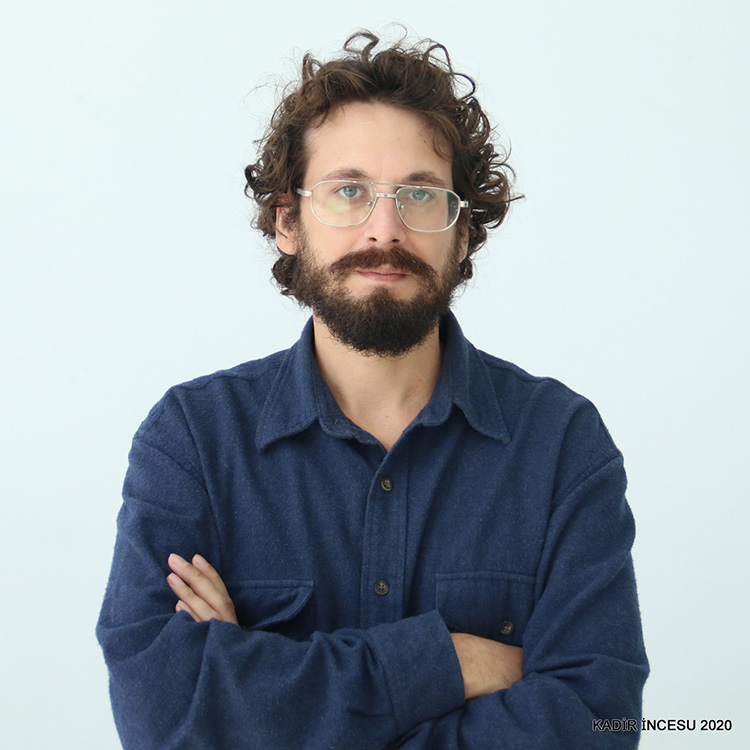Blog
The Appearance of Objects
19 March 2022 Sat
“People can see objects and they can think about the causes of them on their own.” 1
Joseph Beuys
“I count myself amongst those living in ignorant bliss, unable to fathom how a pen is put together
or how the paper I write on evolved from a plant.” 2
Edward Burtynsky
The fourth article of my series titled “The Transformation of the Landscape Image” performs a new materialist reading with reference to Edward Burtynsky’s Shipbreaking series which is featured in the Borusan Contemporary Art Collection.
New materialism had a ground for debate since the second half of the 1990s, especially through the texts by Rosi Braidotti and Manuel DeLanda and it chiefly aims a reconsideration of the object. 3 Different from classical materialism, in this line of thought the object ceases to be an immobile and passive matter requiring representation. Thus, matter as a transforming power by itself does not allow whatsoever representation to take hold. 4 While a new configuration of the object is intended with new materialism, behind this thought there is a will to prevent the over-representation and commodification of the object as well as to transgress the dualities generated by modernity (nature-culture, woman-man, animate-inanimate, matter-soul) through multiplicities.
Using the terms by Rick Dolphijn and Iris van der Tuin the “newness” of new materialism takes place in the rewriting of modernity. 5 Proposing immanence instead of transcendence and horizontal instead of vertical transitivity, it is possible to talk about the prospect of saving things from the “hegemony of sameness” and to bring them together under the umbrella of a “nonlinear” new materialist thought. While Diana Coole and Samantha Frost use the term “renewed materialisms” in order to redefine materialism, they once again associate the dominant role of the materialist age with unprecedented occurrences in production. 6 On the other hand, in a way, this newness adopts a reality that is not anthropocentric. 7 In brief, new materialist thought analyzes animate and inanimate non-human entities through a non-hierarchical approach instead of the anthropocentric way of thinking in the Enlightenment and humanism. Yet, in the new materialist thought, the “new” does not replace the anterior and ignore the past. As Karen Barad points out it proposes an understanding of temporality in which the new does not supersede the old or the one does not win over the other, instead, they coexist. 8

Edward Burtynsky, Shipbreaking #10, Chittagong, Bangladeş, 2000.
Although the context of new materialism seems to take place around the ontology of the object, since it is a theory of culture, feminism, queer theories, philosophy, sociology, art, etc. also feed on this thought. Thus, in order to understand the material and intellectual conditions of the artwork and through the investigation of the ways in which layers of matter become alive, arts feed on the new materialist perspective as well.
According to Timothy Morton, we are living in an age of “hyperobjects” and being surrounded by objects. This concept theorized under the name of “hyperobjects” is used for the things that are extended in time and space. For Morton, while petroleum, global warming, storm, hail, earthquake, hurricane, and tsunami might be a “hyperobject”, Everglades National Park in Florida or an atom bomb is an “hyperobject” too. 9 This idea is also a materialist turn 10 . Because, wherever we look and in every step we take, we feel the presence of the objects.
The works of photographer artist Edward Burtynsky focus on human intervention in landscapes which reflect processes related to objects from leftover stones after human activities to petroleum, from silicone to shipwrecks. Burtynsky works on fields filled with human-made aluminum or plastic compounds rather than what is readily available in nature, and he presents sceneries of an artificial environment. During his shootings in the 1980s, the artist makes use of technology as a way of displaying visuality, and he photographs quarries and mines—in order words human workings— within a perspective in which the field is flattened, and the distance is widened with the help of elongated tripods and 50 feet long bars. 11 In 2005 he passes on to aerial photography and uses drones, planes, and helicopters in his shootings. 12

Edward Burtynsky, Shipbreaking #2, Chittagong, Bangladeş, 2000.
Edward Burtynsky’s relation with the object is crucial. In the end, according to Burtynsky, the objects have different stories of existence in our lives. 13 Our relations with the objects are in fact the manifestation of an alienating relationship. As Burtynsky points out, humans push the object aside when they are bored of it and the object remains as something we only relate to when we own it. This shows us how we keep our distance from the objects. The object enters our lives to fulfill a function and continues to exist until it does not serve a purpose anymore. This reality reminds us of Graham Harman’s Object-Oriented Ontology (O.O.O.). In O. O. O. the objects never get in touch with each other as well as they are never in contact with the human mind. 14 The objects exist in a reciprocal autonomy. According to Harman, the objects recede from each other, they cannot have direct contact. In order for such an interaction to occur a third party, in other words, a mediator should come into play. 15 This definition takes the object as a thing that cannot be reduced to its constituents or its effects on other things and diverges from what Heidegger stated in his text, The Question Concerning Technology. 16 Without a doubt, forgetting the relation of art with the material means losing the significance of immanent material. 17
On the other hand, as Morton points out some objects stick to humans at a level of viscosity. The most typical example of this is petroleum. For Morton, the BP Deepwater Horizon disaster (2010) is an example of viscosity covering both the interiors and exteriors of human and non-human entities with layers of oil. 18 According to Morton, petroleum created a hole in the notion of earth. Edward Burtynsky’s Shipbreaking series (2000) can be considered in this context as well. The origin of the series is based on the Exxon Valdez accident in Alaska on 1989, March 24. As a result of the accident, the oil tanker named Exxon Valdez drains off 10.8 million gallons of petroleum to the sea and severely damages the ecosystem. Afterward, the insurance companies claim that the ship which caused the accident had a single internal wall and they declare that they will not be insuring ships without double internal walls. The ships in question are sent to places like India and Bangladesh to be broken into pieces. Burtynsky’s Shipbreaking series look closer to the doomed ships in Bangladesh.

Edward Burtynsky, Shipbreaking #24, Chittagong, Bangladeş, 2000.
Shipbreaking evokes the theme of shipwreck frequently seen in the tradition of 19th-century Romantic painting. In these paintings, we see the manifestations of nature’s destructive effect on humans and human-made objects in the light of a sublime aesthetic taste. Yet, we may talk about an act of reversal in Burtynsky’s Shipbreaking photographs. Even though a similar sublime taste is felt through the dimensions of the objects and preferences for perspective, in the series of Burtynsky the perpetrator is human in and of himself as an invisible force. The presence of humans positioned over nature and objects is sensed via a hazardous influence.
The concept of landscape is an invented idea that did not exist before and was born out of the desire for seeing, finding, and existing in nature again as humans drift away from it. Anne Cauquelin states that neither a word nor an object which resembles the thing we now call landscape existed in Ancient Greece. 19 Since humans already live a life immanent in nature there was no need for the concept of landscape. However, our conception of landscape indescribably changed with the process that started with the invention of the steam engine by James Watt. The end of the 18th century also marked a new geological time called Anthropocene—directly influential on the earthly existence of humans—with the rise of industrial capitalism and subsequent consumerism. 20 In the 1950s a new geological time starts; Morton terms this as “great acceleration”. At the same time, this phase is the commencement of a new period in arts. According to Morton, this period is an “asymmetrical” phase about which we may speak of the unpredictability of arts. 21
Shipbreaking is a landscape picture featuring the “new” scenery of a landscape filled with objects. As the appearance of objects takes place in different forms through Edward Burtynsky’s lens; reminiscent of disaster scenes, Shipbreaking succeeds in presenting dark, uncanny, aesthetic, ambiguous, indefinite, incomprehensible, and hard to grasp appearances.
1- A quote by Joseph Beuys from the movie Transformer by John Halpern, the text is included in the book titled Üç Gün prepared by Cenan Beykal. Translated by Deniz Derman, Plastik Sanatlar Derneği Yayın Dizisi, İstanbul, 1992, p. 29
3- Rick Dolphijn ve Iris van der Tuin, Yeni Materyalizm, translated by Esra Erdoğan, Yort Kitap, İstanbul, 2019, p. 126
4- Ibid., p. 147
5- Ibid., p. 156-161
6- Diana Coole - Samantha Frost, New Materialisms: Ontology Agency and Politics, Duke University Press, 2010, London, p. 3
7- Christopher N. Gamble, Joshua S. Hanan, Thomas Nail, “What is New Materialism? " , Angelaki Journal of Theoretical Humanities 24(6):111-134, 2019. In the article new materialism is analyzed in three distinct categories: Vital New Materialism, Negative New Materialism, and Performative New Materialism.
8- Karen Barad, Meşakkatli Zaman/lar ve Hiçlik Ekolojileri: Tekrar-Dönme, Tekrar-Hatırlama ve Hesaplanamazla Yüzleşme , translated by Bülent O. Doğan, in “İnsan Sonrası”, Cogito, Yapı Kredi Yayınları issue: 95-96 Winter, 2019, p. 178. Karen Barad states that: “Nothing is new, there is nothing that is not new.” For detailed information check: Karen Barad, Meeting the Universe HalfwayQuantum Physics and the Entanglement of Matter and Meaning, Duke University Press, 2007, London.
9- Timothy Morton, Hipernesneler: Dünyanın Sonundan Sonra Felsefe ve Ekoloji, translated by Bilge Demirtaş, Tellekt Yayınları, 2020, İstanbul, p. 15
10- Diana Coole - Samantha Frost, New Materialisms: Ontology Agency and Politics, Duke University Press, 2010, London, p. 4
11- https://www.format.com/magazine/features/photography/edward-burtynsky-photography-anthropocene-project
12- Ibid.
14- Graham Harman, Nesne Yönelimli Ontoloji: Her Şeyin Yeni Bir Teorisi, translated by Oğuz Karayemiş, Tellekt Yayınları, 2020, İstanbul, p. 32
15- Ibid.
16- Ibid., Martin Heidegger, The Question Concerning Technology and Other Essays, translated by William Lovitt, Garland Publishing, New York & London 1977. According to Heidegger, the hammer serves for building a house, and the house functions as a shelter for humans. Object-Oriented Ontology is exempt from this imperious attitude.
17- D. Rio Adiwijaya, Yasser Rizky, "Techne as Technology and Techne as Art: Heidegger ’s Phenomenological Perspective " , International Journal of Creative and Arts Studies 5(1):13-24, 2018, p. 14.
18- Timothy Morton, Hipernesneler: Dünyanın Sonundan Sonra Felsefe ve Ekoloji, translated by Bilge Demirtaş, Tellekt Yayınları, 2020, İstanbul, p. 54-55
19- Anne Cauqeulin, Peyzajın İcadı, translated by Muna Cedden, Dost Kitapevi, 2016, İstanbul, p. 33
20- Timothy Morton, “Art in the Age of Asymmetry: Hegel, Objects, Aesthetics”, in Aesthetics After Hegel, Vol. 1 No. 1 (2012), p. 131
21- Ibid.
ABOUT THE WRITER
Uras Kızıl is an Istanbul based art historian, critic and researcher.
Kızıl graduated from Mimar Sinan Fine Arts University cum laude in 2015. He studied at the Berlin Freie Universität with the Erasmus program in 2014. Upon his return, he wrote his undergraduate thesis titled Romantic Thought and Romanticism in 19th Century Painting. In 2018, he graduated from Istanbul Technical University Art History Department with his thesis titled The Effects of Romanticism on 20th Century Art. His master's thesis was supported by ITU BAP. Kızıl continues his doctoral studies at Istanbul Technical University.
Working as the archive manager of Galeri Nev Istanbul between 2018-2020, Kızıl's texts have been published in publications including such as e-skop, Manifold, Argonotlar, K24, as well as in exhibition catalogs and books since 2015.
Kızıl, who is a member of AICA, teaches at the Department of Art Management at Kültür University.




